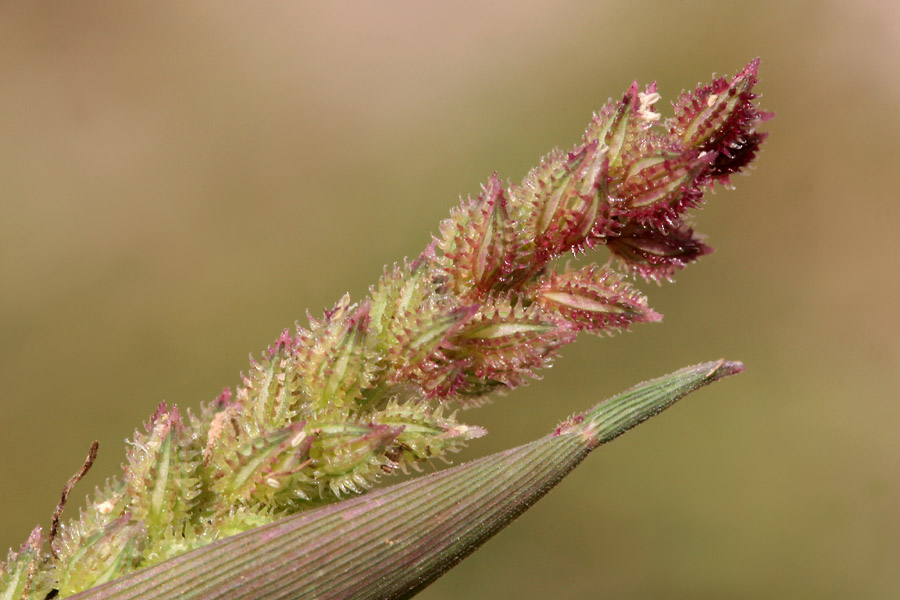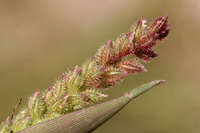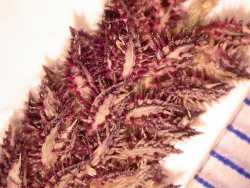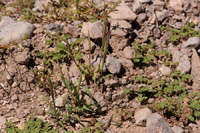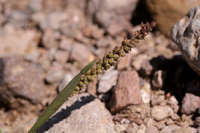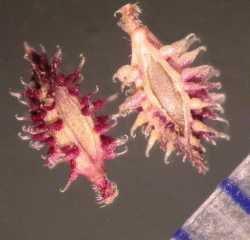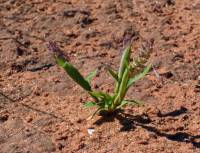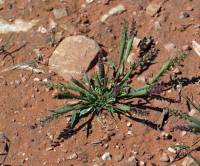Plants annual. Culms (2)3.5-45 cm. Ligules 0.5-1 mm; blades (0.5)0.7-8.5 cm long, 1.2-5 mm wide, glabrous. Panicles (1)2-13 cm long, (3)4-8 mm wide; rachises pubescent; branches (0.5)0.7-2.7 mm, pubescent, with 2(3) spikelets, axes occasionally extending past the distal spikelets; proximal internodes 0.2-0.6(0.7) mm, shorter than the second internodes. Proximal spikelets (1.8)2-4.3 mm; second spikelets (0.8)1-3.9 mm, sometimes sterile. Lower glumes 0.1-0.6 mm, membranous, minutely pubescent; upper glumes 1.8-4.3 mm, minutely pubescent, 5-veined, rarely with 1-2 additional veins adjacent to the midvein; glume projections (4)6-14, in 5 rows, (0.2)0.3-1 mm, uncinate; lemmas (1.5)1.8-3.1 mm, sparsely pubescent on the back, midveins occasionally excurrent to 0.6 mm; paleas (1.3)1.5-2.4 mm; anthers 3, 0.4-0.6 mm, yellow, occasionally purple- or green-tinged. Caryopses (0.9)1.2-2 mm long, 0.4-0.8 mm wide. 2n = 20.
Tragus berteronianus is native to Africa and Asia, and is now established in Arizona, New Mexico, and Texas. It was collected in Maine, Massachusetts, New York, and Virginia in the nineteenth century, and Virginia in 1959.
Common Name: spiked bur grass
Duration: Annual
Nativity: Non-Native
Lifeform: Graminoid
General: Introduced annual grass, geniculate with thick, spreading stems 3-45 cm, broad sheaths, uppermost strongly inflated with reduced blades.
Vegetative: Blades 0.5-9 cm long, 1-5 mm wide, glabrous with whitish, coarsely hispid-ciliate margins; ligule 0.5-1 mm, a ring of short wooly hairs.
Inflorescence: Spikelike, 2-13 cm long, 4-8 mm wide, spikelets one-flowered, 2-3 mm long, in burrlike clusters of 2-5, clusters fall as unit from persistent main axis; lower glumes less than 0.5 mm, membranous, minutely pubescent, upper glumes 1-5 mm, minutely pubescent, with three rows of stout, hooked spines; lemmas 1-3 mm, sparsely pubescent on back, midveins occasionally excurrent to 0.6 mm.
Ecology: Found in dry or moist canyons and washes, roadsides and waste places from 4,000-6,000 ft (1219-1829 m); flowers spring to early summer.
Distribution: Native to Africa and South Asia, Introduced to Northe and South America, including HI, AZ, NM, TX, and much of the northeast coast.
Notes: The genus Tragus has seven species, all of which are native to the tropics and subtropics of the Eastern Hemisphere; four have been introduced into North America. The genus is easily recognized by the spinelike projections on the upper glumes. T. berteronianus is distinguished from T. racemosus, also present in the Southwest, by its tight, cylindrical inflorescence with smaller florets (2-3 mm). T. racemosus has a looser inflorescence, which tends to be interrupted (has gaps between the florets) toward the bottom, and larger spikelets (4-5 mm).
Ethnobotany: Unknown
Etymology: Tragus is thought to be from the Greek tragos, meaning goat, while berteronianus is named for Carlo Giuseppe Bertero (1789-1831) an Italian physician.
Synonyms: Nazia aliena
Editor: SBuckley 2010, FSCoburn 2015, AHazelton 2015


